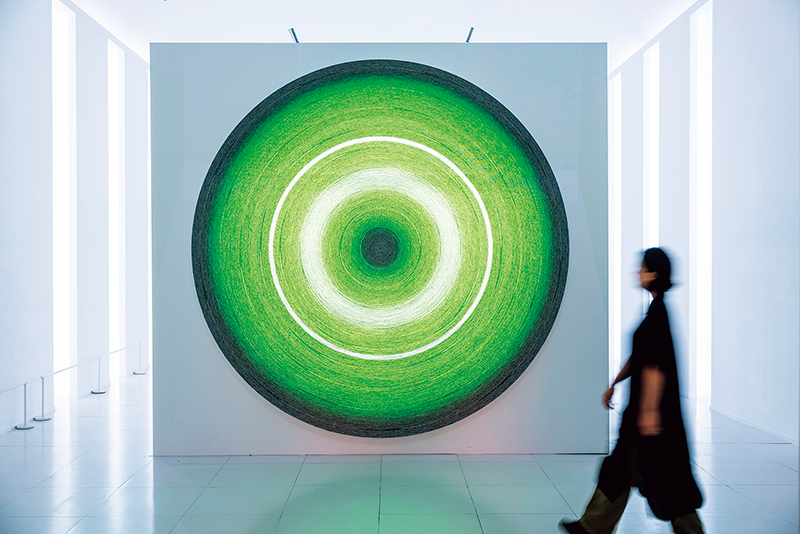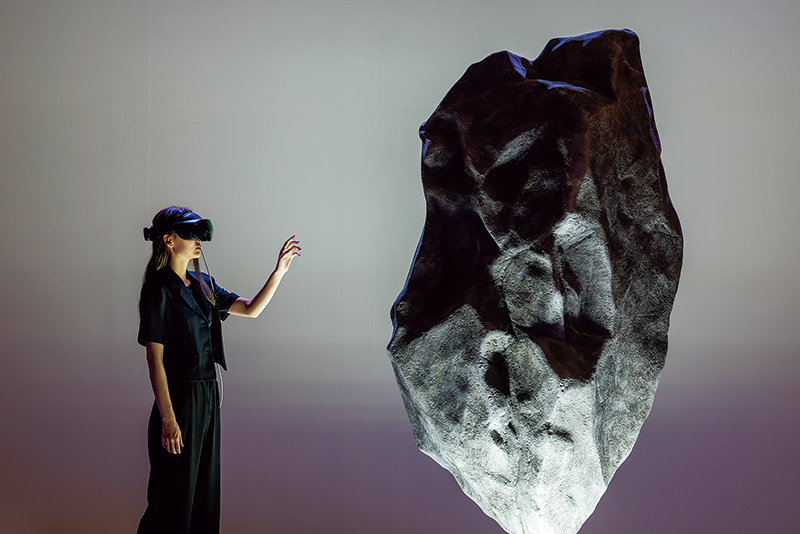Lately, there has been a remarkable increase in support for Korean artists from tech giants and other companies. These collaborations are part of their corporate philosophies, aimed at enhancing the value of their respective brands. The newfound partnerships make it easier for artists to express their imagination and allow people to enrich their everyday lives with innovative art experiences.

A Guest in Paradise. Jeon Byeong Sam. 2023. Projection mapping on a concentricof photographs. Diameter: 300 cm.
This work, exhibited at the 2023 Paradise Art Lab Festival, depicts an alien microorganism enlarged three billion times to a diameter of about three meters. The Paradise Art Lab is a project organized by the Paradise Cultural Foundation to spotlight works that fuse art and technology.
© Paradise Cultural Foundation
Legendary video art pioneer Nam June Paik once cited the old adage, “Art is short, and life is long,” when asked about the deteriorating condition of The More, The Better, his famous tower of TV sets. Paik knew that art based on technological means can be transient—sometimes lasting less than a generation—especially as more advanced technologies emerge year after year. Paik’s response could also be seen as a declaration that art and technology no longer last forever. Today, media art is riding the wave of technology, transcending the borders among art genres, with businesses frequently entering the realm of artistic innovation.
Corporate Philosophy
On a day in September 2023, a meteorite crashed into the indoor plaza of Paradise City. So imagined a group of artists whose works filled the art space of the luxurious resort situated on Yeongjong Island off Korea’s west coast. By donning VR goggles, visitors could closely observe the fictional meteorite and appreciate the vastness of the cosmos. They could also immerse themselves in music and light inspired by the mineral composition analysis of the meteorite.
The works featured in this experience included ECHOSPHERE by Kim Dong-wook and Jeon Jin-kyung of media artist duo ROOMTONE, Meteorite Appraisal by new media artist Park Keun-ho (Chamsae), and Transmitting Wave Signals into the Cosmos by computer music composer and audiovisual artist Jeho Yun, among others. They were part of the 2023 Paradise Art Lab Festival.
The Paradise Art Lab, organized by the Paradise Cultural Foundation since 2018, is a project for exploring contemporary art and envisioning its future. It supports the creation, production, and distribution of interactive artworks that engage with the public. Why would a resort company sponsor media art? The answer lies in the Paradise Group’s concept of leisure, which goes beyond mere relaxation and enjoyment. The belief that artistic experiences encountered in leisure destinations can inspire and captivate people is rooted in its corporate philosophy.
Fresh Experiences

Meteorite Appraisal. Park Keun-ho (Chamsae). 2023. Crystal Beads, steel frame, motors, and LEDs. 600 × 240 × 240 cm.
This work, exhibited at the 2023 Paradise Art Lab Festival, depicted a meteorite that has fallen to Earth. Artist Park Keun-ho (Chamsae) is known for his media works that fill space with physical properties. Tothe meteorite, he installed modules made of crystals and light that resonate with energy particles to study how a meteorite radiates energy.
© Paradise Cultural Foundation

Echosphere. ROOMTONE. 2023. Virtual reality and video installation. 4 minutes.
This work by ROOMTONE, a duo comprising Kim Dong-wook and Jeon Jin-kyung, uses metaphorical images and narratives to depict the interconnectedness of humans and the universe and the meaning of existence. The artists focus on the immersive experience that arises from the interaction between real and virtual senses by using virtual reality and digital games as their medium. This work also appeared at the 2023 Paradise Art Lab Festival.
© Paradise Cultural Foundation
Around the same time as the festival, Frieze Seoul and KIAF Seoul, two global art fairs, were taking place at Coex, Korea’s largest exhibition and convention center in Gangnam. Amid a sea of expensive masterpieces, one particularly luminous work captured visitors’ attention: a piece by Kim Whanki (1913–1974), a master of Korean abstract art, brought to life on an OLED TV screen by LG Electronics. Crimson dots, forming concentric circles in his 14-III-72 #223, radiated brilliantly on the large wireless screen, seemingly surpassing the limits of sharpness and depth perception. Viewers found themselves instantly immersed in the world of this artwork. If the late artist, who dedicated his life to exploring the waves, sounds, and movements generated by color and form, had witnessed this work, he may have been filled with amazement.
LG OLED, under the umbrella of LG Electronics, joined as the headline partner for this year’s Frieze Seoul, an extraordinary development given that Deutsche Bank, the main sponsor throughout the art event’s 20-year history, made the unusual decision to step back. Art fairs typically find their most enduring partnerships with banks—Art Basel with UBS, the TEFAF New York and Maastricht fairs with the Bank of America, or Frieze with Deutsche Bank—in recognition of the fact that the banks’ VIP clients often overlap with high-net-worth individuals who view works of art as valuable investments. However, in forging connections with the art world, LG OLED, a technology company rather than a financial institution, is now closely linked to the transformative change brought about by the Fourth Industrial Revolution in the manufacturing sector.
“Companies can no longer thrive by just selling products; now, they must market their unique culture. Some economists even argue that businesses focusing solely on sales may eventually become subcontractors for more culturally conscious companies,” notes Seo Jin-seok, the director of the Busan Museum of Art, who previously spearheaded the development of the Ulsan Art Museum that specializes in media art.
Seo champions the “Neo-Bauhaus era,” which refers to the revival of the early 20th century Bauhaus movement that sought to combine artistic aesthetics with technological functionality. “As technological advances become an integral part of our daily lives, they transform our very existence,” he emphasizes. “When companies materialize technology into devices or appliances, it’s not enough to assign them merely technical or functional roles. Rather, imbuing them with artistic sensibility allows these devices to seamlessly integrate into consumers’ lives.”
Infusion is Key

Visitors at the SHOUT Art Hub & Gallery in Hong Kong’s Hysan Place shopping mall view the digital art exhibition The Frame Digital Art Gala, which used Samsung Electronics’ lifestyle TV “The Frame.” The exhibition, a collaboration between Samsung Electronics and SHOUT Gallery, was held in 2022.
© Samsung Electronics

Vibration Club 2020. Oh Do-hahm. 2020. PVC airball, tactile transducer, bass shaker, variable dimension amplifier.
Artist Oh Do-hahm, who is active in music, performance planning, and fine arts, has developed a device that allows you to enjoy music by tactile means. In the process, he was inspired by how a hard-of-hearing person feels music through the vibration of a speaker attached to a mattress. It is one of the works exhibited at the Open Studio held by ZER01NE, a creative talent platform sponsored by Hyundai Motor Group in 2020.
© ZER01NE
Technological progress in and of itself s functional environments, but it is the infusion of art that fosters a cultural atmosphere. Therefore, companies with technological expertise are advocating “fresh experiences” over the “cutting-edge” cliché.
Examples of the use of thin and transparent OLED technology can now be found in several museums. From May to October 2023, the National Museum of Korea in Seoul hosted an exhibition titled Companions on the Eternal Journey: Earthenware Figurines and Vessels from Ancient Korea. The event featured a large collection of pottery items excavated from tombs of the ancient Silla Dynasty (57 BCE–935 CE) and the Gaya Confederacy (42– 532 CE).
The museum displayed images of people’s daily lives from 1,600 years ago on a 17 mm-thick transparent LG OLED screen, which appeared to form the glass panel of a display case. Adults were filled with awe and children approached with wonder. In the museum’s permanent exhibition of Greek and Roman art, displays such as a bust sculpture of Zeus appearing amidst lightning and clouds are also brought to life through LG OLED technology.
In 2022, LG Electronics embarked on a five-year partnership with the Guggenheim Museum, launching the LG Guggenheim Art and Technology Initiative to promote the fusion of art and avant-garde technology while enhancing its brand value. The LG Guggenheim Award, established as part of this project, annually bestows $100,000 to an artist who has d an outstanding innovative work of art using new technologies.
Expanding Breadth
Meanwhile, Samsung Electronics has harnessed its technological expertise to bring masterpieces from renowned art museums into the living room. Subscribers to the Samsung Art Store can display works of art on “The Frame,” one of the tech giant’s lifestyle TV lines. The database includes approximately 2,300 artworks in various genres, including paintings from world-renowned art museums and galleries such as the Prado Museum in Madrid and the Belvedere in Vienna, as well as photographs, illustrations, and digital art, all in 4K resolution. This strategic approach aims to increase access to art through TV technology, enabling people to forge a closer connection with the world of art in their daily lives.
Hyundai Motors is another key p at the intersection of technology and media art. The company maintains a separate division known as Hyundai Artlab, through which it engages in discourses on global change. The automaker partners with institutions such as the Los Angeles County Museum of Art (LACMA) for the LACMA Art + Technology Lab, and runs programs in collaboration with Bloomberg Media, including Bloomberg ART + TECHNOLOGY.
Also gaining recognition are its support programs for media artists, such as the VH AWARD, the ZER01NE Creative Talent Platform, and the Hyundai Blue Prize Art + Tech, a project aimed at assisting media art curators. A company official commented on these efforts, “Technology is no longer just a tool; it is evolving into the very environment that surrounds us. The present age demands a redefinition of the relationship between humans and machines.” She added, “In an era of dazzling advances in artificial intelligence technology, the ability to pose creative questions has become even more important. Under these circumstances, it is crucial to look into the present and prepare for the future at the confluence of art and technology.”
Art Shifts Competition
Companies that once competed on the basis of manufacturing expertise have shifted their focus to changes beyond technology. Han Yeo-hoon, a professor at Hongik University’s Graduate School of Arts and Cultural Management, has conducted research on consumer psychology and arts marketing. In Han’s view, business competition before 2000 was based on performance, but now that technological gaps have been minimized, only perfect innovation sets companies apart.
“Contemporary artists are no longer fixated on replicating art based on technique but are using technology to infuse their philosophy and values into new forms of artwork,” says Han. “It is precisely in this area that art is converging with the concept of corporate innovation.”
Han also points out that while you can produce TV sets by applying OLED technology to products, its integration into artworks opens up greater possibilities. She explains, “For technological innovation to be captivating, it requires the imaginative and creative process of harnessing that technology. The scope of technology’s application becomes boundless when this task is given to artists.” This is why art shines even brighter when it teams up with technology.